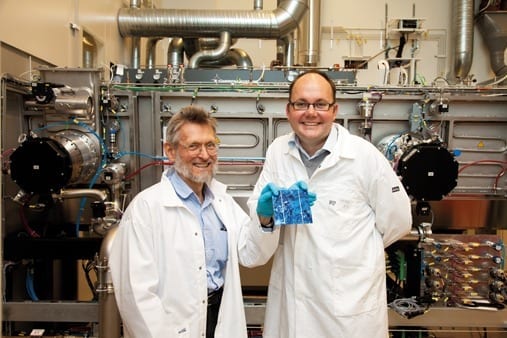A team of materials scientists at Harvard University and the University of Exeter, UK, have invented a new fiber that changes color when stretched.
Inspired by nature, the researchers identified and replicated the unique structural elements that create the bright iridescent blue color of a tropical plant’s fruit.
The multilayered fiber, described today in the journal Advanced Materials, could lend itself to the creation of smart fabrics that visibly react to heat or pressure.
“Our new fiber is based on a structure we found in nature, and through clever engineering we’ve taken its capabilities a step further,” says lead author Mathias Kolle, a postdoctoral fellow at the Harvard School of Engineering and Applied Sciences (SEAS). “The plant, of course, cannot change color. By combining its structure with an elastic material, however, we’ve created an artificial version that passes through a full rainbow of colors as it’s stretched.”
Since the evolution of the first eye on Earth more than 500 million years ago, the success of many organisms has relied upon the way they interact with light and color, making them useful models for the creation of new materials. For seeds and fruit in particular, bright color is thought to have evolved to attract the agents of seed dispersal, especially birds.
The fruit of the South American tropical plant, Margaritaria nobilis, commonly called “bastard hogberry,” is an intriguing example of this adaptation. The ultra-bright blue fruit, which is low in nutritious content, mimics a more fleshy and nutritious competitor. Deceived birds eat the fruit and ultimately release its seeds over a wide geographic area.
“The fruit of this bastard hogberry plant was scientifically delightful to pick,” says principal investigator Peter Vukusic, Associate Professor in Natural Photonics at the University of Exeter. “The light-manipulating architecture its surface layer presents, which has evolved to serve a specific biological function, has inspired an extremely useful and interesting technological design.”
Vukusic and his collaborators at Harvard studied the structural origin of the seed’s vibrant color. They discovered that the upper cells in the seed’s skin contain a curved, repeating pattern, which creates color through the interference of light waves. (A similar mechanism is responsible for the bright colors of soap bubbles.) The team’s analysis revealed that multiple layers of cells in the seed coat are each made up of a cylindrically layered architecture with high regularity on the nano- scale.
The team replicated the key structural elements of the fruit to create flexible, stretchable and color-changing photonic fibers using an innovative roll-up mechanism perfected in the Harvard laboratories.
“For our artificial structure, we cut down the complexity of the fruit to just its key elements,” explains Kolle. “We use very thin fibers and wrap a polymer bilayer around them. That gives us the refractive index contrast, the right number of layers, and the curved, cylindrical cross-section that we need to produce these vivid colors.”
The researchers say that the process could be scaled up and developed to suit industrial production.
via Harvard SEAS









